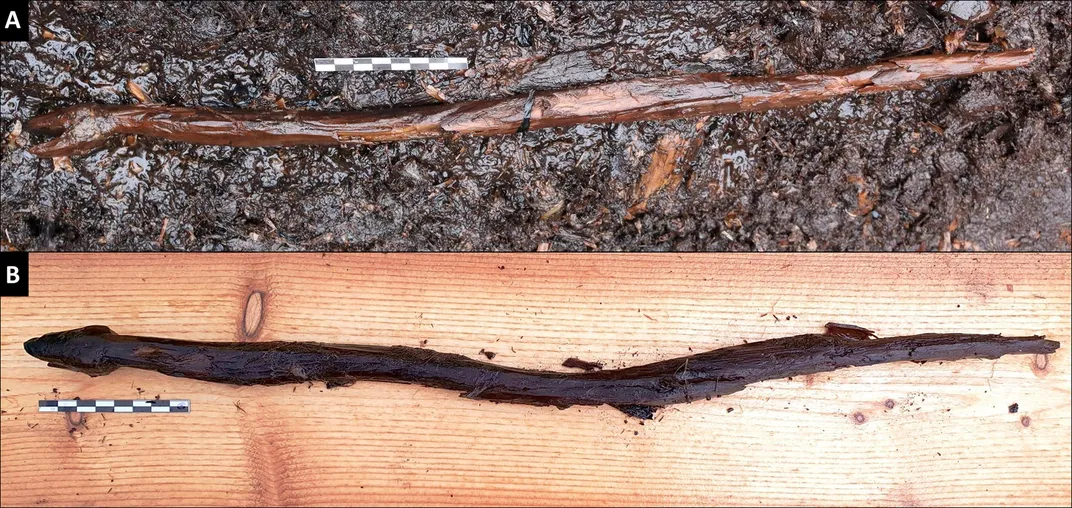4,000-Year-Old ‘Snake Staff’ Discovered in Finland
A Stone Age shaman may have used the carving during special rituals
:focal(211x211:212x212)/https://tf-cmsv2-smithsonianmag-media.s3.amazonaws.com/filer/69/26/6926d3d0-ea7b-4436-bae0-2ff8772e9bed/urn_cambridgeorg_id_binary_20210624102146770-0816_s0003598x2100079x_s0003598x2100079x_fig4.png)
Researchers have discovered a 4,400-year-old wooden staff shaped like a snake near a lake in southwest Finland.
As Owen Jarus reports for Live Science, archaeologists Satu Koivisto, Antti Lahelma and their research team discovered the carving beneath a layer of peat in Järvensuo, a late Stone Age site about 75 miles northwest of Helsinki. Experts used radiocarbon dating to determine that the 21-inch-long snake dates to the Neolithic period, about 4,000 to 6,000 years ago, and believe that an ancient shaman may have used the object for magical rituals. The team published their findings on June 29 in the journal Antiquity.
“I have seen many extraordinary things in my work as a wetland archaeologist, but the discovery of this figurine made me utterly speechless and gave me the shivers,” Koivisto, a study co-author and postdoctoral researcher at the University of Turku in Finland, tells Live Science in a statement.
Scientists believe that Stone Age peoples occupied the area where the staff was located from 4000 B.C. to 2000 B.C., notes Jesse Holth for ARTnews. In the 1950s, a ditch digging team accidentally discovered the archaeological site, but experts didn’t fully excavate it. Then, in 2019, scholars started digs at Järvensuo for the first time in 35 years, writes George Dvorsky for Gizmodo. The wetland has yielded several well-preserved artifacts, including objects made from wood, bark and bone that date back thousands of years.
According to ARTnews, craftsmen wrought the animal carving from a single piece of wood. The life-size snake has an open mouth and a long, slightly curved body, as if it's slithering or swimming away. Researchers involved with the study hypothesize that the piece depicts a grass snake (Natrix natrix) or a European adder (Vipera berus). However, other scholars have posited that another classification may be more accurate.
“I would say that a viper is more correct, due to the shape of its head, the short body and distinguishable tail,” Sonja Hukantaival, a postdoctoral researcher in Nordic Folkloristics at Åbo Akademi University in Finland who is unaffiliated with the study, tells Live Science in an email. “This is interesting, since the viper has an important role in much later (historical) folk religion and magic.”
Experts believe that a shaman would have used the staff during a religious or spiritual ceremony. They also surmise that a mystical leader could have used it to talk to the dead, because ancient people in the region thought that a “Land of the Dead” existed within wetlands, notes ARTnews. Furthermore, shamans assumed that they could transmute into snakes, which also connects the ritualistic object and the magical realm.
Other highlights of the most recent excavations include a wooden spoon, wooden receptacles and paddles, fishing tools, ceramics and other artifacts, per the study.
“There seems to be a certain connection between snakes and people,” says Lahelma, a study co-author and archaeologist at the University of Helsinki, in a statement, as quoted by National Geographic's Kristin Romey. “This brings to mind northern shamanism of the historical period, where snakes had a special role as spirit-helper animals of the shaman … Even though the time gap is immense, the possibility of some kind of continuity is tantalizing: Do we have a Stone Age shaman's staff?”
Other Stone Age civilizations revered snakes and included them in shamanic rituals. As ARTnews points out, many northern European sites feature Neolithic rock art with snake motifs; one site in Finland contains a picture with a human figure carrying a snake in hand. And in 2019, archaeologists found a 1,500-year-old piece of fossilized human feces, which had the remains of a whole rattlesnake. After analyzing the feces, experts determined that someone probably ate the animal for ritualistic reasons and not for nourishment.
/https://tf-cmsv2-smithsonianmag-media.s3.amazonaws.com/accounts/headshot/Isis_Davis-Marks_thumbnail.png)

/https://tf-cmsv2-smithsonianmag-media.s3.amazonaws.com/filer/26/c2/26c29f08-afd5-4883-8ef3-6fb50f6b8af1/urn_cambridgeorg_id_binary_20210624102146770-0816_s0003598x2100079x_s0003598x2100079x_fig2.png)

/https://tf-cmsv2-smithsonianmag-media.s3.amazonaws.com/accounts/headshot/Isis_Davis-Marks_thumbnail.png)